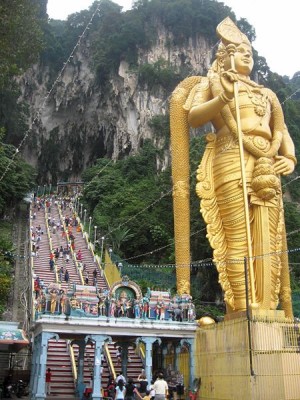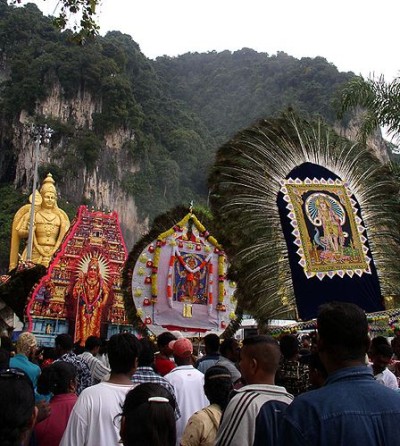Batu Caves (Kuala Lumpur)
 Batu Caves is a limestone hill, which has a series of caves and cave temples,
located in Gombak district, 13 kilometres (8.1 mi) north of Kuala Lumpur,
Malaysia. It takes its name from the Sungai Batu or Batu River, which flows past
the hill. Batu Caves is also the name of the nearby village.
Batu Caves is a limestone hill, which has a series of caves and cave temples,
located in Gombak district, 13 kilometres (8.1 mi) north of Kuala Lumpur,
Malaysia. It takes its name from the Sungai Batu or Batu River, which flows past
the hill. Batu Caves is also the name of the nearby village.
The cave is one of the most popular Hindu shrines outside India, dedicated to
Lord Murugan. It is the focal point of Hindu festival of Thaipusam in Malaysia.
The limestone forming Batu Caves is said to be around 400 million years old.
Some of the cave entrances were used as shelters by the indigenous Temuan people
(a tribe of Orang Asli).
As early as 1860, Chinese settlers began excavating guano for fertilising their
vegetable patches. However, they became famous only after the limestone hills
were recorded by colonial authorities including Daly and Syers as well as
American Naturalist, William Hornaday in 1878.
Batu Caves was promoted as a place of worship by K. Thamboosamy Pillai, an
Indian trader. He was inspired by the 'vel'-shaped entrance of the main cave and
was inspired to dedicate a temple to Lord Muruga within the caves.
In 1890, Pillai, who also founded the Sri Mahamariamman Temple, Kuala Lumpur,
installed the murti (consecrated statue) of Sri Subramania Swamy in what is
today known as the Temple Cave. Since 1892, the Thaipusam festival in the Tamil
month of Thai (which falls in late January/early February) has been celebrated
there.
Wooden steps up to the Temple Cave were built in 1920 and have since been
replaced by 272 concrete steps. Of the various cave temples that comprise the
site, the largest and best known is the Temple or Cathedral Cave, so named
because it houses several Hindu shrines beneath its 100 m vaulted ceiling.
Religious Site
 Standing at 42.7 meter (140.09 ft) high, the world's tallest statue of Murugan,
a Hindu deity, is located outside Batu Caves, near the city of Kuala Lumpur,
Malaysia. The statue, which cost approximately Rupees 24 million, is made of
1550 cubic metres of concrete, 250 tonnes of steel bars and 300 litres of gold
paint brought in from neighboring Thailand.
Standing at 42.7 meter (140.09 ft) high, the world's tallest statue of Murugan,
a Hindu deity, is located outside Batu Caves, near the city of Kuala Lumpur,
Malaysia. The statue, which cost approximately Rupees 24 million, is made of
1550 cubic metres of concrete, 250 tonnes of steel bars and 300 litres of gold
paint brought in from neighboring Thailand.
Rising almost 100 m above the ground, Batu Caves temple complex consists of
three main caves and a few smaller ones. The biggest, referred to as Cathedral
Cave or Temple Cave, has a 100 m-high ceiling, and features ornate Hindu
shrines. To reach it, visitors have to climb a steep flight of 272 steps.
At the base of the hill are two more cave temples, Art Gallery Cave and Museum
Cave, both of which are full of Hindu statues and paintings. This complex was
renovated and opened as the Cave Villa in 2008. Many of the shrines relate the
story of Lord Murugan's victory over the demon Soorapadam. An audio tour is
available to visitors.
The Ramayana Cave is situated to the extreme left as one faces the sheer wall of
the hill. On the way to the Ramayana Cave, there is a 50-foot (15 m) tall murti
of Hanuman and a temple dedicated to Hanuman, the noble monkey devotee and aide
of Lord Rama. The consecration ceremony of the temple was held in November 2001.
The Ramayana Cave depicts the story of Rama in a chronicle manner along the
irregular walls of the cave.
A 42.7m (140.09 feet high) high statue of Lord Muruga was unveiled in January
2006, having taken 3 years to construct. It is the tallest Lord Muruga statue in
the world.
Batu Malai Sri Subramaniar Temple is managed by the Board of Management of Sri Maha Mariamman Temple Devasthanam, which also manages the Sri Mahamariamman Temple, Kuala Lumpur and the Kortumalai Pillaiyar Temple. It also performs the role of Hindu Religious Consultant to the Government of Malaysia in determining the Hindu yearly calendar.
Festivals
Icons carried in procession during Thaipusam at Batu Caves. Also seen in the
background is the 42.7 m high golden statue of Lord Muruga.
Batu Caves serves as the focus of the Hindu community's yearly Thaipusam (Tamil:
தைபூசம்) festival. It has become a pilgrimage site for not only Malaysian
Hindus, but Hindus worldwide from countries such as India, Australia and
Singapore.
 A procession begins in the wee hours of the morning on Thaipusam from the Sri
Mahamariamman Temple, Kuala Lumpur leading up to Batu Caves as a religious
undertaking to Lord Muruga lasting eight hours. Devotees carry containers
containing milk as offering to Lord Muruga either by hand or in huge decorated
carriers on their shoulders called 'kavadi'.
A procession begins in the wee hours of the morning on Thaipusam from the Sri
Mahamariamman Temple, Kuala Lumpur leading up to Batu Caves as a religious
undertaking to Lord Muruga lasting eight hours. Devotees carry containers
containing milk as offering to Lord Muruga either by hand or in huge decorated
carriers on their shoulders called 'kavadi'.
The kavadi may be simple wooden arched semi-circular supports holding a carrier
foisted with brass or clay pots of milk or huge, heavy ones which may rise up to
two metres, built of bowed metal frames which hold long skewers, the sharpened
end of which pierce the skin of the bearers torso. The kavadi is decorated with
flowers and peacock feathers imported from India. Some kavadi may weigh as much
as a hundred kilograms.
After a bath in the nearby Sungei Batu (Rocky River), the devotees wend their
way to the Temple Cave and with remarkable endurance they climb the flights of
stairs to the temple in the cave. Devotees use the wider centre staircase while
worshippers and onlookers throng up and down those balustrades off on either
side.
When the kavadi bearer arrives at the foot of the 272 step stairway leading up
to the Temple Cave, the devotee has to make the arduous climb against gravity-
against the press of the bustling masses.
Priests attend to the kavadi bearers. Consecrated ash is sprinkled over the
hooks and skewers piercing the devotees flesh before they are removed. No blood
is shed during the piercing and removal.
In 2007, the festival attracted more than 1.5 million pilgrims, making it one of
the largest gatherings in history.



